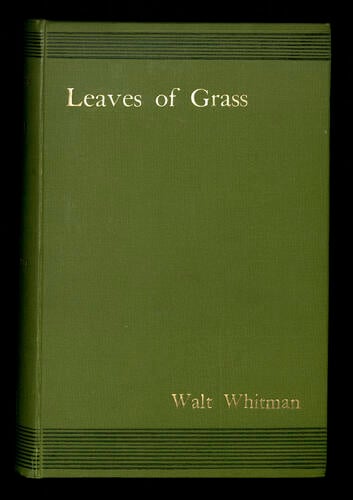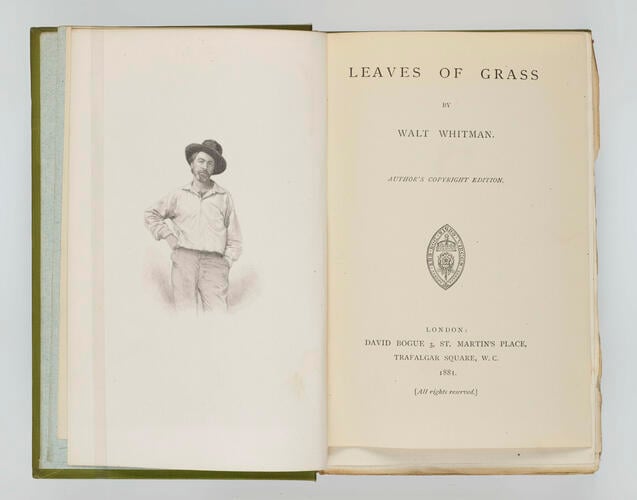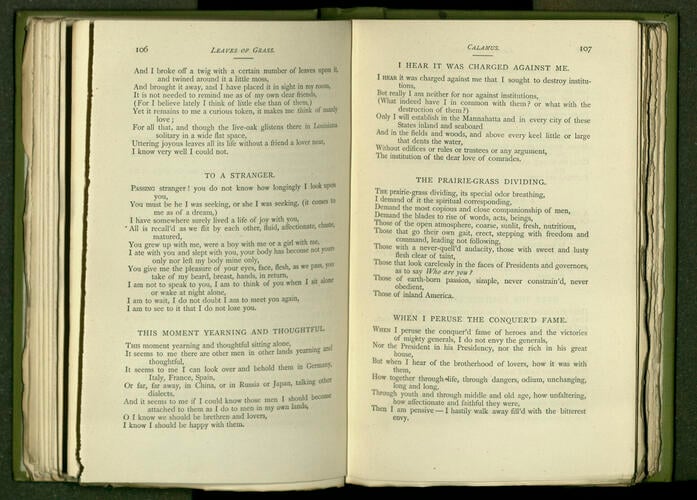-
1 of 253523 objects
Leaves of grass / by Walt Whitman. 1881
20.6 x 14.1 x 2.8 cm (book measurement (conservation)) | RCIN 1085302





-
Regarded as one of the greatest anthologies of American poetry, Leaves of Grass is the magnum opus of the poet Walt Whitman. Begun in response to an 1854 article by Ralph Waldo Emerson that called for a unique American style of literature, free from the constraints of Europe, to embody the true character of the nation, Whitman published his first edition in 1855 and continued to work on it for the remainder of his life, producing several distinct editions.
The first edition, published anonymously by the Brooklyn printers James and Andrew Rome, bore a frontispiece with a portrait of the 37-year-old poet, the only indication of his authorship. The poems, rather than focusing on depictions of the landscape or allegory, instead described the thoughts, feelings and passions of the idealised self of Whitman. The 95-page work sold tolerably well but its critical reception was divisive. Of the five reviews the book received, three were written anonymously by Whitman in praise of the text, another was lukewarm and the last denounced it for its explicit homoeroticism.
Nevertheless, some writers, notably Emerson and his circle, praised the book and Whitman followed his first edition with a greatly expanded second the following year: the 95 pages growing to 384. He included a quotation from a letter he had received from Emerson regarding the work in place of a dedication. This annoyed the essayist, who began to criticise the later editions.When preparing his third edition of 1860, Whitman approached the Boston publishing firm of James Osgood but opted instead for the radical firm of Thayer and Eldridge. This edition was the first to include his Calamus sequence, the most controversial of the poems in Leaves of Grass due to its overt descriptions of same-sex attraction, inspired by Whitman's relationship with Fred Vaughan. His decision to publish with Thayer and Eldridge proved to be a mistake as the firm collapsed soon after the book’s publication, leaving Whitman with only $250 in royalties. However, by his sixth edition of 1881, Whitman was working with Osgood, who by that time had become the major publisher of American literature and the American publisher of British writers such as Charles Dickens and Alfred, Lord Tennyson.
In preparation for the new edition Whitman completely rearranged his poems and on the book’s publication, he fought off criticism from Boston authorities demanding that Osgood withdraw or censor the most explicit parts of the work. However, by May 1882, after sustained pressure from the Boston District Attorney, who rejected Whitman's minor amends to the text, the book was withdrawn from circulation.Due to the controversy surrounding the ban on the sixth edition in Boston, Leaves of Grass became much sought after and in 1882 a new impression from Osgood’s plates was published at Philadelphia by the Scottish publisher David McKay. It became the most successful of all of the editions. While he added two ‘annexes’ and rearranged the contents several times before his death, Whitman did not produce another new edition of the book.
This is a copy of the British imprint of the 1881 edition, published by David Bogue from Osgood’s unsold stock. Bogue was not the first choice for Whitman but, following a rejection by the British distributors of the American editions, Trübner & Co., in late 1881, he was advised by his London agent Josiah Child to select the young printer. Bogue had also published Oscar Wilde’s Poems earlier that year.
Whitman would go on to meet Wilde on his tour of the United States of America in January 1882. The 27-year-old Wilde saw the 62-year-old Whitman as a role model and wrote of the inspiration of Leaves of Grass, particularly William Rosetti's 1868 bowdlerised edition, on his own works. Bogue’s edition, made from 400 copies of Osgood’s text and bound with a new title page bearing the date 1881 and marked as the ‘Author’s Copyright Edition’, was published in early 1882. By August 1882, Bogue declared bankruptcy, his assets were seized and both Wilde and Whitman were forced to seek new publishers.
Provenance
Acquired by Queen Victoria.
-
Creator(s)
(publisher)Acquirer(s)
-
Measurements
20.6 x 14.1 x 2.8 cm (book measurement (conservation))
Category
Object type(s)